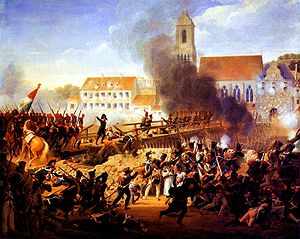Heinrich XV, Prince Reuss of Greiz
Heinrich XV, Prince Reuss of Greiz | |
|---|---|
Inhaber Infantry Regiment # 17 (1801–1825) |
Heinrich XV, Prince Reuss of Greiz (22 February 1751 – 30 August 1825) was the fourth of six sons born into the reigning family of the
Prince Heinrich came to the attention of the Habsburg king in his thirties. After distinguishing himself in battle against the Turks, the emperor promoted him to command an infantry regiment. He served against the
In 1799 Prince Heinrich fought against France in Germany and Switzerland. He led a division in northern Italy during the War of the Third Coalition. In the Danube campaign of 1809, he started out leading a division and ended the war in command of a corps. In 1813, he led a successful diplomatic effort to cause the Kingdom of Bavaria to change sides and join the Allies against Napoleon. Into his seventies he served Austria in various military and civil positions.
Early career
Heinrich XV was born into an ancient
Heinrich XV enlisted in the Austrian Macquire Infantry Regiment # 35 in 1766. He, his father, and brothers became princes in 1778. When
French Revolutionary Wars
War of the First Coalition
In the spring of 1793, Prince Heinrich successfully defended a position against the French and received promotion to General-Major in May. He served on the staff of Prince Josias of Saxe-Coburg-Saalfeld and was present at the Battle of Avesnes-le-Sec on 12 September.[2] In this action, Prince Johann of Liechtenstein and 2,000 cavalry crushed a force of 7,000 French troops, inflicting 2,000 casualties and capturing 2,000 more.[3] At the beginning of 1796, Reuss commanded an infantry brigade on the upper Rhine.[2]

Bonaparte's victories over
During the second relief of Mantua, Heinrich led a 5,200-man brigade in Paul Davidovich's corps. His area of responsibility stretched from the northern tip of Lake Garda to Trento on the west side of the Adige river.[6] On 3 September a 10,000-man French division led by Claude Belgrand de Vaubois drove his outposts out of Nago–Torbole on the lake. An overconfident army command ordered him to attack the French the next day, but he admitted that this was not possible.[7] In the subsequent Battle of Rovereto on 4 September, he defended the camp of Mori on the west bank, while his colleagues Josef Vukassovich and Johann Sporck held Marco on the east bank. Bonaparte in greatly superior strength routed Davidovich's corps and drove them north of Trento.[8]
In the fourth relief of Mantua, the new army commander József Alvinczi assigned Reuss to command the largest column in his army, nearly 7,900 soldiers.[9] Reuss followed the west bank of the Adige, while Vukassovich's column marched on the east bank, and the rest of the army followed roads and trails farther west near Monte Baldo. During the Battle of Rivoli, the troops under Reuss bravely fought their way out of the river bottom to the plateau against tenacious resistance. At this moment, a desperate French counterattack panicked some Austrians from the other columns and drove them to seek refuge in the river valley. Disordered by fleeing troops and attacked from two sides by the French, Reuss' column retreated to the bottom of the gorge where their commander managed to rally them.[10] With Reuss checked, Bonaparte defeated the remaining Austrians on the plateau and won the battle.[10]
Heinrich was promoted to Feldmarschal-Leutnant on 1 March 1797. During the withdrawal from Italy that month, Reuss led a division in the left wing under Archduke Charles, retreating to Ljubljana (Laibach).[2]
War of the Second Coalition
On 25 and 26 March 1799, Heinrich fought under Archduke Charles at the
Napoleonic Wars
Heinrich served under Archduke Charles in Italy during the

The
On 15 May, Heinrich received promotion to
In 1813, he commanded the Army of the Danube, a corps of observation on the
Notes
- better source needed]
- ^ a b c d e f g h Kudrna & Smith 2009, R25.
- ^ Smith 1998, pp. 54–55.
- ^ Fiebeger 1911, p. 13.
- ^ Boycott-Brown 2001, p. 394.
- ^ Boycott-Brown 2001, p. 418.
- ^ Boycott-Brown 2001, p. 423.
- ^ Boycott-Brown 2001, pp. 424–425.
- ^ Boycott-Brown 2001, p. 492.
- ^ a b Boycott-Brown 2001, p. 514.
- ^ Smith 1998, p. 158.
- ^ Pivka 1979, pp. 82–84.
- ^ Schneid 2002, p. 165.
- ^ Schneid 2002, p. 170.
- ^ Schneid 2002, pp. 35–36.
- ^ Schneid 2002, pp. 39–40.
- ^ Rothenberg 1982, p. 99.
- ^ Bowden & Tarbox 1980, p. 69.
- ^ Smith 1998, p. 293–294.
- ^ Smith 1998, p. 298.
- ^ Rothenberg 1982, p. 149.
- ^ Bowden & Tarbox 1980, p. 130.
- ^ Bowden & Tarbox 1980, pp. 165–168.
- ^ Smith 1998, p. 323–324.
- ^ Chandler 1996, p. 730.
References
- Bowden, Scotty; Tarbox, Charlie (1980). Armies on the Danube 1809. Arlington, Texas: Empire Games Press.
- Boycott-Brown, Martin (2001). The Road to Rivoli. London: Cassell & Company. ISBN 0-304-35305-1.
- Chandler, David (1996). The Campaigns of Napoleon. New York: Macmillan.
- Fiebeger, G. J. (1911). The Campaigns of Napoleon Bonaparte of 1796–1797. West Point, New York: US Military Academy Printing Office.
- Kudrna, Leopold; Smith, Digby (2009). "Reuss-Plauen, Heinrich XV". A Biographical Dictionary of all Austrian General during the French Revolutionary and Napoleonic Wars ° 1792–1815. The Napoleon Series.
- Pivka, Otto von (1979). Armies of the Napoleonic Era. New York: Taplinger Publishing. ISBN 0-8008-5471-3.
- ISBN 0-253-33969-3.
- Schneid, Frederick C. (2002). Napoleon's Italian Campaigns: 1805–1815. Westport, Conn.: Praeger Publishers. ISBN 0-275-96875-8.
- ISBN 1-85367-276-9.)
{{cite book}}: CS1 maint: location missing publisher (link
